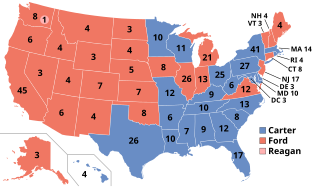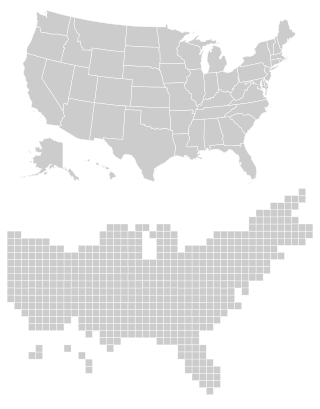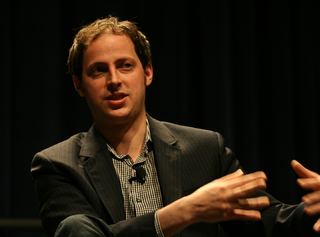Related Research Articles

The 1876 United States presidential election was the 23rd quadrennial presidential election, held on Tuesday, November 7, 1876.

The 1848 United States presidential election was the 16th quadrennial presidential election, held on Tuesday, November 7, 1848. In the aftermath of the Mexican–American War, General Zachary Taylor of the Whig Party defeated Senator Lewis Cass of the Democratic Party.

The 1872 United States presidential election was the 22nd quadrennial presidential election, held on Tuesday, November 5, 1872. Despite a split in the Republican Party, incumbent President Ulysses S. Grant defeated Democratic-endorsed Liberal Republican nominee Horace Greeley.

The 1976 United States presidential election was the 48th quadrennial presidential election, held on Tuesday, November 2, 1976. The Democratic nominee, former Georgia governor Jimmy Carter, narrowly defeated incumbent Republican President Gerald Ford. This was the first presidential election since 1932 in which the incumbent was defeated, as well as the only Democratic victory of the six presidential elections between 1968 and 1988.

The Twenty-third Amendment to the United States Constitution extends the right to participate in presidential elections to the District of Columbia. The amendment grants to the district electors in the Electoral College, as though it were a state, though the district can never have more electors than the least-populous state. How the electors are appointed is to be determined by Congress. The Twenty-third Amendment was proposed by the 86th Congress on June 16, 1960; it was ratified by the requisite number of states on March 29, 1961.
An electoral college is a set of electors who are selected to elect a candidate to particular offices. Often these represent different organizations, political parties or entities, with each organization, political party or entity represented by a particular number of electors or with votes weighted in a particular way. The United States has been the only democracy in the 21st century that still uses an electoral college to select its executive president. The other democracies that used an electoral college for these elections switched to direct elections in the 19th or 20th century.:215

In the United States, the Electoral College is the group of presidential electors that is formed every four years during the presidential election for the sole purpose of voting for the president and vice president. The process is described in Article II of the U.S. Constitution. The number of electoral votes a state has equals its number of Senators (2) plus its number of Representatives in the House of Representatives, the latter being dependent on the Census's reported population. Each state appoints electors using legal procedures determined by its legislature, equal in number to its congressional delegation totaling 535 electors in the 50 states. A 1961 amendment granted the federal District of Columbia three electors. Federal office holders, including senators and representatives, cannot be electors. Of the current 538 electors, a simple majority of 270 or more electoral votes is required to elect the president and vice president. If no candidate achieves a majority there, a contingent election is held by the House of Representatives to elect the president and by the Senate to elect the vice president.

FairVote is a 501(c)(3) organization and lobbying group in the United States. It was founded in 1992 as Citizens for Proportional Representation to support the implementation of proportional representation in American elections. Its focus changed over time to emphasize instant-runoff voting (IRV), a national popular vote, and universal voter registration. It changed its name to the Center for Voting and Democracy in 1993 and to FairVote in 2004.

The National Popular Vote Interstate Compact (NPVIC) is an agreement among a group of U.S. states and the District of Columbia to award all their electoral votes to whichever presidential ticket wins the overall popular vote in the 50 states and the District of Columbia. The compact is designed to ensure that the candidate who receives the most votes nationwide is elected president, and it would come into effect only when it would guarantee that outcome.
National Popular Vote Inc. is a non-profit organization based in Los Altos, California, launched in 2006 by Barry Fadem and John Koza. Its purpose is "to study, analyze and educate the public regarding its proposed interstate compact providing for the nationwide popular election of the President of the United States," and it developed and champions the National Popular Vote Interstate Compact.
Bills have been introduced in the US Congress on several occasions to amend the US Constitution to abolish or to reduce the power of the Electoral College and to provide for the direct popular election of the US president and vice president.
Electoral reform in the United States refers to efforts to change American elections and the electoral system used in the United States.

Electoral reform in New York refers to efforts to change the voting and election laws in New York State. In 2021, the New York State Legislature asked New York state voters their opinion through referendums on ballot proposals, all of which were denied by voters.

Electoral reform in Colorado refers to efforts to change the voting laws in the Centennial State.
Electoral reform in Texas refers to efforts to change the voting and election laws in the State of Texas.

The election of the president and the vice president of the United States is an indirect election in which citizens of the United States who are registered to vote in one of the fifty U.S. states or in Washington, D.C., cast ballots not directly for those offices, but instead for members of the Electoral College. These electors then cast direct votes, known as electoral votes, for president, and for vice president. The candidate who receives an absolute majority of electoral votes is then elected to that office. If no candidate receives an absolute majority of the votes for president, the House of Representatives elects the president; likewise if no one receives an absolute majority of the votes for vice president, then the Senate elects the vice president.

Statewide elections in the U.S. state of North Dakota take place every two years. Most executive offices and all legislators are elected to four-year terms, with half the terms expiring on U.S. Presidential election years, and the other half expiring on mid-term election years.

The concept of a "tipping-point state" is used in some analyses of United States presidential elections. In a list of states ordered by decreasing margin of victory for the winning candidate, the tipping point state is the first state where the combined electoral votes of all states up to that point in the list give the winning candidate a majority in the Electoral College.
The United States Electoral College was established by the U.S. Constitution, which was adopted in 1789, as part of the process for the indirect election of the President and Vice-President of the United States. The institution has been criticized since its establishment and a number of efforts have been made to reform the way it works or abolish it altogether. Any change would require a constitutional amendment. In 1971, one of these attempts was almost successful in being proposed to the States. An interstate compact proposal, which would bypass the requirement for a constitutional amendment, is at 76% of successful completion as of August 2023.
References
- "New Jersey Rejects Electoral College" Accessed June 2, 2009